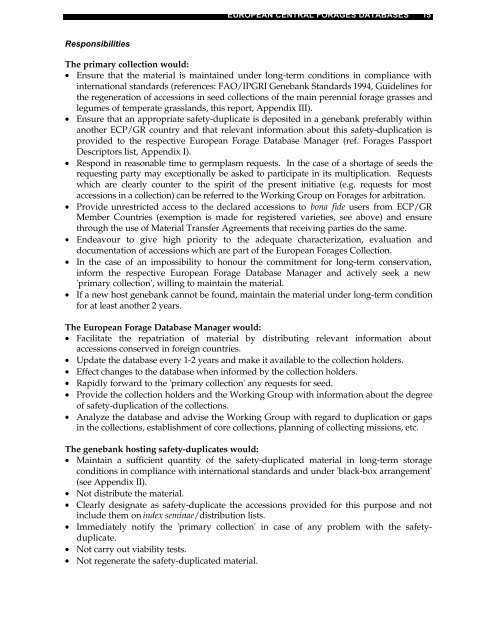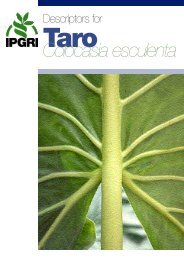Download PDF (6215 kb) - Bioversity International
Download PDF (6215 kb) - Bioversity International
Download PDF (6215 kb) - Bioversity International
You also want an ePaper? Increase the reach of your titles
YUMPU automatically turns print PDFs into web optimized ePapers that Google loves.
Responsibilities<br />
EUROPEAN CENTRAL FORAGES DATABASES 15<br />
The primary collection would:<br />
• Ensure that the material is maintained under long-term conditions in compliance with<br />
international standards (references: FAO/IPGRI Genebank Standards 1994, Guidelines for<br />
the regeneration of accessions in seed collections of the main perennial forage grasses and<br />
legumes of temperate grasslands, this report, Appendix III).<br />
• Ensure that an appropriate safety-duplicate is deposited in a genebank preferably within<br />
another ECP/GR country and that relevant information about this safety-duplication is<br />
provided to the respective European Forage Database Manager (ref. Forages Passport<br />
Descriptors list, Appendix I).<br />
• Respond in reasonable time to germplasm requests. In the case of a shortage of seeds the<br />
requesting party may exceptionally be asked to participate in its multiplication. Requests<br />
which are clearly counter to the spirit of the present initiative (e.g. requests for most<br />
accessions in a collection) can be referred to the Working Group on Forages for arbitration.<br />
• Provide unrestricted access to the declared accessions to bona fide users from ECP/GR<br />
Member Countries (exemption is made for registered varieties, see above) and ensure<br />
through the use of Material Transfer Agreements that receiving parties do the same.<br />
• Endeavour to give high priority to the adequate characterization, evaluation and<br />
documentation of accessions which are part of the European Forages Collection.<br />
• In the case of an impossibility to honour the commitment for long-term conservation,<br />
inform the respective European Forage Database Manager and actively seek a new<br />
'primary collection', willing to maintain the material.<br />
• If a new host genebank cannot be found, maintain the material under long-term condition<br />
for at least another 2 years.<br />
The European Forage Database Manager would:<br />
• Facilitate the repatriation of material by distributing relevant information about<br />
accessions conserved in foreign countries.<br />
• Update the database every 1-2 years and make it available to the collection holders.<br />
• Effect changes to the database when informed by the collection holders.<br />
• Rapidly forward to the 'primary collection' any requests for seed.<br />
• Provide the collection holders and the Working Group with information about the degree<br />
of safety-duplication of the collections.<br />
• Analyze the database and advise the Working Group with regard to duplication or gaps<br />
in the collections, establishment of core collections, planning of collecting missions, etc.<br />
The genebank hosting safety-duplicates would:<br />
• Maintain a sufficient quantity of the safety-duplicated material in long-term storage<br />
conditions in compliance with international standards and under 'black-box arrangement'<br />
(see Appendix II).<br />
• Not distribute the material.<br />
• Clearly designate as safety-duplicate the accessions provided for this purpose and not<br />
include them on index seminae/distribution lists.<br />
• Immediately notify the 'primary collection' in case of any problem with the safetyduplicate.<br />
• Not carry out viability tests.<br />
• Not regenerate the safety-duplicated material.




